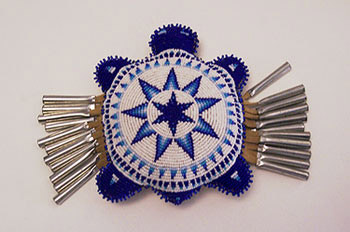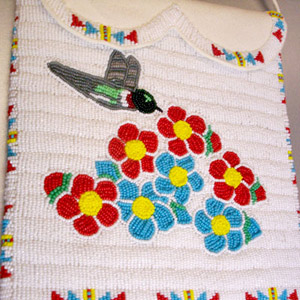Home
About Us
Current News
Event Calendar
Artist Bios
ARCHIVES
Display IDEAS
Collecting Tips
Gen Arts/Crafts Info
Testimonials
Hours/Directions
Online Store
Artist Bio: Carol Pate (Choctaw)

Elena Carol Pate's creativity and love of color can be seen in her beadwork and dolls. A Choctaw artist, she was born in Hugo, Oklahoma, and was raised by her grandmother until the age of five when her grandmother passed away. Left without other close family ties, Carol was adopted by a family in Oklahoma City. "It wasn't until I was grown and married that I began to create my own art," says Carol. After her marriage to Rick Pate and the birth of their first daughter, Amber, Carol wanted to reconnect with her Choctaw heritage. She began teaching herself beadwork and researching the styles and patterns. She took classes with Native beadworkers, Patricia Moustrail and Hennrietta Tsoti, at the American Indian Cultural Society, a local Indian cultural organization.
After seeing her work, Carol's mother, Sharon Hazleton, and her friend, Delores Pratt, encouraged Carol to sell her work. Delores entered Carol's work at the Gallup Inter-tribal Ceremonial. Carol won first and second place awards. Rick's parents, Ed and Hanna Pate, were happy to have Carol's work at the Tribes Gallery they operated in Norman, Oklahoma, selling art from the region.

Today, Carol is one of the top beadworkers in the country, winning top honors for her work at juried American Indian art shows. Carol is known for her vibrant colors and eye for contrast and design. She uses one of the smallest sizes of beads, size 13, to create her intricate patterns. She also uses cut glass faceted beads that capture the light and turn each piece into one of dazzling beauty.

Carol uses what is called a "lazy stitch" for rows of beads. Anything but lazy, this stitch takes great control to get the beads sized uniformly and the tension consistent enough to make the beads lie smoothly. She uses what is called a "peyote stitch" when she needs to make a circular pattern or sew the bead around an object. " I don't draw my designs," says Carol. " When I begin a piece, I choose my colors and put the ones I want into one bowl. My husband thinks I'm crazy, but I like picking each bead out and seeing how the design evolves."
Turtles are a recurring theme in Carol's work. "Turtles are important to the Choctaw," says Carol, "We even have a Turtle Dance to honor them." Carol makes several sizes of beaded turtles, from a few inches to almost twelve inches. She also makes lizards and frogs. "My animals are reminiscent of the umbilical fetishes made by mothers for their children," says Carol. Children's umbilical cords were sewn into the fetishes and were kept by the children throughout their lives. They represented the tie to their mothers, families and nation. "The turtles and frogs were usually given to the boys, and the lizards were given to the girls," says Carol.
Carol has made traditional dolls upon request, but enjoys making contemporary dolls with colors and designs of her own artistic vision. She has made miniature beaded cradleboards, purses, moccasins and many accessories. She enjoys her beading and is creative in all of her work. An expert beader today, Carol also shares her knowledge with others, passing along what she has learned.


